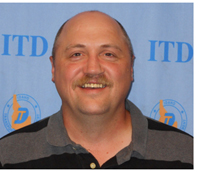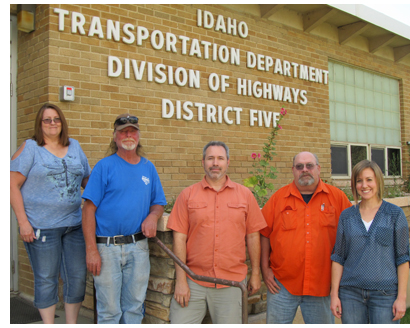
District simplifies and standardizes seal coating to save significant time for necessary process that protect highways
D5 innovation borrows on momentum from expatriate now in D2, has “Times 7” potential
One of last year’s 275 ITD implemented innovations statewide involves standardizing and simplifying the seal-coating process, an activity that every district performs multiple times each year. District 5, propelled forward by an initiative from an employee now in District 2, reduced the amount of time they spent annually to prepare the seal-coat package.
Depending on how many seal coats were in a package, it could take 4-8 weeks to complete the preparation. That can be reduced to just a few hours each, once the appendices (discussed below) are complete.
Another way to look at it is the time of P.E. as a rough equation to cost savings. Where it cost $4,000-$10,000 each before, now it costs on average $2,000-$3,000. 
In addition, under the old format, any lessons learned on this year’s projects would not be applied until next year’s projects.
“It would take a few years to catch up, and we would miss some projects as well,” explained District 5 Engineering Manager Mark Snyder.
Curtis Arnzen (pictured below), who started the ball rolling on this initiative, took the Project Development Engineer position in District 2, and Ed Bala (D5 District Engineer) liked walking down the hall and saying, “You know, Curtis can do one of these seal coats in about 10 minutes and 5 of that is getting a cup of coffee.”
“I started wondering what we could do to make the annual seal coat project a single package that we reuse,” Synder added.
In other words, last year’s seal coat project is the template for this year’s project, and next year’s.
The key was the appendix.
The appendix lays out the quantities and locations. The main body describes things common to every seal coat. The first three paragraphs were revised to describe the project and any changes from what’s described in the appendix.
In the case of District 5, they chose a countywide approach. Each appendix gives critical information for either a full county or half a county that allows the work to be completed in one year
.
“For instance, if we’re doing northern Bannock County this year, we could just refer to the Northern Bannock County Appendix.
The appendix tells them when and where to chip seal, fog the crossovers, avoid bridge decks, and more.
Total quantities are then moved to the pay items section in the first three paragraphs.
Pictured, left to right, the D5 Simplified Seal Coat Team: Joan Kley, Jim Menard, Mark Snyder, Steve Davis and Andrea Sheppard.
“When we construct one year’s project, we update the template based on lessons learned and that will automatically carry forward to all future seal coats.
Snyder added that even though D5 set this up on a countywide basis, it could be adapted for a fixed-price, variable-quantity approach.
Times 7 Focus: Ideally, these innovations will not live in a silo — they will be catalysts for ITD’s other district offices and work areas, and inspire duplication statewide. These innovations represent time and money-saving measures, process improvements, and customer-service efficiencies that are transferrable to other districts. In that spirit, if this innovation is something you’d like to adapt to your own district or work space, and you have any questions, please contact District 5 Innovation Steward Greydon Wright at 5-3611.
“Arnzen’s fixed-price, variable-quantity pioneering work actually was a precursor to how you would lay out a simplified seal coat, so it wouldn’t take much for D2 to adopt something similar. And adopting this concept statewide would be well worth the effort,” said Snyder.
Published 08-19-16